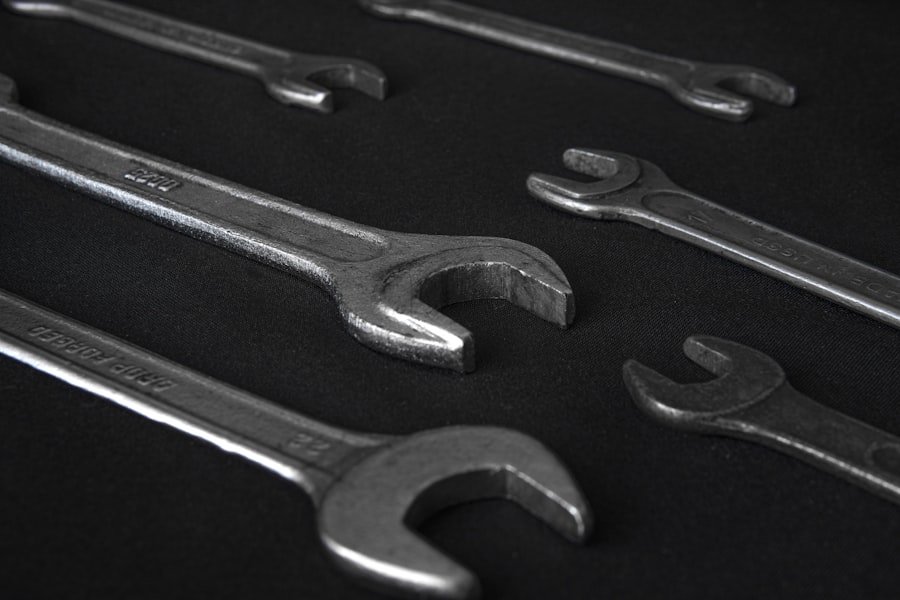Basic hand tools are essential for DIY enthusiasts and professional tradespeople. These manually operated tools are crucial for various tasks, from simple home repairs to complex woodworking projects. Common basic hand tools include hammers, screwdrivers, pliers, wrenches, and hand saws.
Hammers are used for driving nails and shaping metal, available in various sizes and styles for different tasks. Screwdrivers, used for turning screws, come in different types like flathead and Phillips head to accommodate various screw designs. Pliers are versatile tools for gripping, bending, and cutting materials, while wrenches are used for tightening or loosening nuts and bolts.
Hand saws, used for cutting wood, come in different tooth patterns and blade lengths for various cutting applications. Other essential basic hand tools include tape measures, levels, and utility knives. Tape measures are used for taking measurements, levels ensure surfaces are straight and even, and utility knives are versatile cutting tools for various tasks such as cutting materials and opening packages.
These basic hand tools form the foundation of any toolbox and are essential for successful DIY projects and professional trade jobs.
Key Takeaways
- Basic hand tools are essential for any DIY project and include items such as hammers, screwdrivers, pliers, and wrenches.
- Power tools, such as drills, saws, and sanders, can make tasks easier and more efficient, but proper safety precautions should always be taken when using them.
- Measuring and marking tools, like tape measures, levels, and marking pencils, are crucial for ensuring accuracy in any project.
- Safety equipment, including goggles, gloves, and ear protection, should always be worn when working with tools to prevent accidents and injuries.
- Fastening and joining tools, such as nails, screws, and glue, are necessary for securing materials together in a project.
Power Tools
Types of Power Tools
Drills are versatile tools that can be used for drilling holes and driving screws, and they come in various sizes and styles to accommodate different tasks. Saws, such as circular saws and jigsaws, are used for cutting various materials, including wood, metal, and plastic. Sanders are used for smoothing surfaces and removing material, while grinders are used for shaping and sharpening materials.
Additional Power Tools
Other common power tools include nail guns, impact drivers, and rotary tools. Nail guns are used for quickly and efficiently driving nails into materials, while impact drivers are used for driving screws with high torque. Rotary tools are versatile handheld tools that can be used for cutting, grinding, polishing, and engraving various materials.
Importance of Power Tools
Power tools are essential for any workshop or job site and can greatly increase productivity and efficiency.
Measuring and Marking Tools

Accurate measurements and markings are crucial for any successful construction or woodworking project. Measuring and marking tools are designed to ensure precision and accuracy in all types of tasks. Some of the most common measuring and marking tools include tape measures, squares, levels, and marking pencils.
Tape measures come in various lengths and styles and are used for taking measurements of different lengths. Squares, such as combination squares and speed squares, are used for marking straight lines and angles on materials. Levels are used for ensuring that surfaces are straight and even, while marking pencils are used for making clear and visible markings on materials.
Other common measuring and marking tools include calipers, rulers, chalk lines, and marking gauges. Calipers are used for measuring internal and external dimensions of objects with high precision, while rulers are used for measuring straight lines of various lengths. Chalk lines are used for making long straight lines on surfaces, while marking gauges are used for marking precise measurements on wood.
These measuring and marking tools are essential for any construction or woodworking project and can greatly improve the accuracy and quality of the finished product.
Safety Equipment
| Product | Usage | Price |
|---|---|---|
| Safety Goggles | Eye protection | 15 |
| Hard Hat | Head protection | 20 |
| Ear Plugs | Hearing protection | 5 |
Safety should always be a top priority when working with hand and power tools. Safety equipment is designed to protect workers from potential hazards and injuries in the workshop or job site. Some of the most common safety equipment includes safety goggles, ear protection, gloves, and dust masks.
Safety goggles are essential for protecting the eyes from flying debris, dust, and other potential hazards. Ear protection, such as earplugs or earmuffs, is crucial for protecting the ears from loud noises produced by power tools and machinery. Gloves are important for protecting the hands from cuts, abrasions, and other injuries, while dust masks are essential for protecting the respiratory system from inhaling harmful dust particles.
Other common safety equipment includes hard hats, steel-toed boots, and knee pads. Hard hats are essential for protecting the head from falling objects or overhead hazards, while steel-toed boots provide protection for the feet from heavy objects or sharp materials. Knee pads are important for protecting the knees from strain or injury when working on hard surfaces.
Safety equipment should always be worn when working with hand or power tools to ensure a safe and productive work environment.
Fastening and Joining Tools
Fastening and joining tools are essential for connecting materials together securely and efficiently. These tools are crucial for a wide range of tasks, from simple home repairs to complex construction projects. Some of the most common fastening and joining tools include screws, nails, bolts, and adhesives.
Screws are versatile fasteners that can be used to securely join materials together, while nails are commonly used for fastening materials to wood or other surfaces. Bolts are used for securing heavy loads or structures together, while adhesives such as glue or epoxy can be used to bond materials together permanently. Other common fastening and joining tools include staples, rivets, clamps, and dowels.
Staples are used for fastening materials together quickly and efficiently, while rivets are used for joining metal sheets or structures together. Clamps are essential for holding materials together while adhesives or fasteners are applied, while dowels can be used to join wood pieces together in a strong and durable manner. Fastening and joining tools are essential for any construction or woodworking project and can greatly impact the strength and durability of the finished product.
Painting and Finishing Tools

Common Painting and Finishing Tools
Some of the most common painting and finishing tools include paint brushes, rollers, sprayers, sanders, and scrapers. Paint brushes come in various sizes and styles to accommodate different painting tasks, while rollers are used for applying paint to large surfaces quickly and evenly. Sprayers can be used to apply paint or stain to surfaces in a fine mist for a smooth finish. Sanders are essential for smoothing surfaces before painting or finishing, while scrapers can be used to remove old paint or finishes from surfaces.
Additional Tools for Painting and Finishing
Other common painting and finishing tools include putty knives, caulking guns, paint trays, and masking tape. Putty knives are used for filling holes or cracks in surfaces before painting or finishing, while caulking guns can be used to apply sealants or adhesives to surfaces. Paint trays are essential for holding paint or stain during application, while masking tape is important for creating clean lines or protecting surfaces from unwanted paint or finishes.
The Importance of Painting and Finishing Tools
Painting and finishing tools are essential for adding the final touches to any construction or woodworking project and can greatly impact the overall appearance and quality of the finished product.
Specialty Tools
Specialty tools are designed for specific tasks or applications that may not be covered by basic hand or power tools. These tools are often designed to perform unique functions that cannot be accomplished with standard tools. Some of the most common specialty tools include pipe cutters, tile saws, laminate trimmers, and drywall saws.
Pipe cutters are designed specifically for cutting pipes with precision and accuracy, while tile saws are used for cutting ceramic or stone tiles with ease. Laminate trimmers can be used to trim laminate materials with precision, while drywall saws are designed specifically for cutting through drywall quickly and efficiently. Other common specialty tools include rebar cutters, wire strippers, tubing benders, and insulation knives.
Rebar cutters are essential for cutting reinforcing bars with ease, while wire strippers can be used to strip insulation from electrical wires safely. Tubing benders are designed specifically for bending metal tubing without kinking or flattening it, while insulation knives can be used to cut through insulation materials with precision. Specialty tools are essential for completing specific tasks or applications that may arise during construction or woodworking projects.
These tools can greatly improve efficiency and accuracy when working on unique or specialized tasks.
FAQs
What are tools emoji?
Tools emoji are a set of digital icons or symbols that represent various tools and equipment used for different purposes. These emojis are commonly used in digital communication to convey the idea of working with tools or fixing things.
What are some examples of tools emoji?
Some examples of tools emoji include hammer and wrench, screwdriver, saw, wrench, pliers, and many others. These emojis are designed to represent a wide range of tools commonly used in various tasks and activities.
How are tools emoji used in digital communication?
Tools emoji are used in digital communication to convey the idea of working with tools, fixing things, or engaging in DIY projects. They can be used in text messages, social media posts, and other forms of digital communication to add visual emphasis to the message.
Are tools emoji available on all platforms?
Yes, tools emoji are available on most digital platforms and devices, including smartphones, computers, and social media platforms. They are part of the Unicode standard, which ensures that they can be displayed and used across different platforms.
Can tools emoji be customized or modified?
In most cases, tools emoji cannot be customized or modified by users. However, some platforms may offer variations of certain tools emoji, such as different colors or designs. Overall, the appearance of tools emoji is standardized across different platforms.


